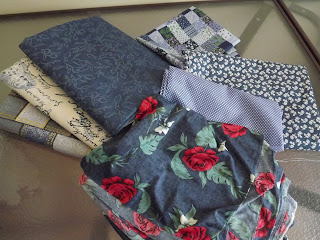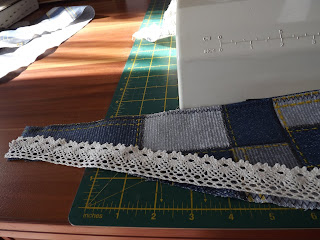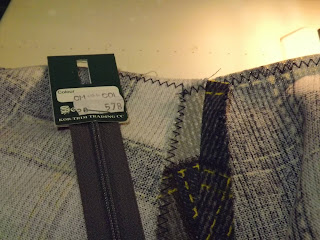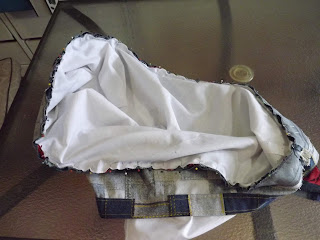I decided to drop into the fabric shop on a whim today. I came back with this delightful collection.
I rummaged through the fabric stash I had hidden in the wardrobe and found some more pieces that would match the new purchases nicely.
I then sat down and started sketching an idea I had for a skirt.
The design settled my thoughts on this selection of fabric for the project.
Then I decided that such a pretty skirt would need something nice to wear with it. So, I quickly sketched an idea for a waistcoat.
It seemed only natural to then sketch a plan for a shirt as well.
All in all, I would end up making three pieces of clothing. I will tell you more about the top and waistcoat in forthcoming blogs. For now, we will concentrate our attention on the skirt.
I took my own measurements and quickly drew a rough pattern for the basque of the skirt.
I then cut the top layer of the basque, as well as the waistband.
The middle section of the basque was cut next.
Finally, it was time to cut the bottom piece of the basque. I would leave cutting the frills for the next day, as it was already getting late and I wanted to make a start with the project.
My overlocker still needs to go in for repairs, so I was forced to zigzag all of the pieces.
I then lay down the lace on the hem of the top section of the basque.
The lace was sandwiched between the top and middle pieces of the basque.
I then sewed this little sandwich together.
I then sandwiched another piece of lace in between the middle and bottom pieces of the basque.
These were also sewn together.
I then folded the waistband in half and sewed the one end together.
The other end of the waistband would need an overlap and I sewed it accordingly.
Drop the needle to sew around the corner.
Trim the corner away and turn the waistband inside out.
Iron the waistband flat.
Sew the various seams on the basque flat as well.
Progress photo.
Pin the two short side seams of the basque together.
Sew the short side seam of the basque.
Find the centre of the waistband.
Pin the centre of the waistband to the short side seam of the basque.
I only pin the waistband to the basque so that I can see where, and how deep, I must pin the darts.
Sew the darts to take away excess fabric in the waist.
Now pin the long side seam of the basque.
Sew this side seam.
Find a 20 cm zipper to put in the skirt.
Iron the side seams open. Pin the zipper to the long side seam.
Sew the zipper onto the skirt.
Unpick the side seam over the zipper.
You now have a perfectly practical zipper in your side seam.
Pin the waistband onto the basque and sew only one side of the waistband onto the basque.
Fold the open side of the waistband in and pin it.
Set your sewing machine for top stitching.
Sew all around the waistband.
Mark the space for the button.
Sew the buttonhole.
Open the buttonhole.
Mark the space for the button with a pin stuck through the buttonhole.
Sew the button onto the skirt.
The basque is now finished and we can devote our attention to the frills of the skirt.
Cut the fabric for the first frill.
Sew the short ends together.
Sew the long ends together.
Cut the fabric for the second frill.
Cut the diagonal line for the frill.
Sew the seems together.
Cut the fabric for the third frill.
Cut the diagonal line.
Sew the seams.
Cut the fabric for the last frill as you had done for the first three.
Sew the side seams together.
I will now cut a false skirt to go under all of the frills.
This is what the false skirt looks like.
Zigzag or overlock the edges.
Sew the side seams together.
Zigzag or overlock the top of the first frill.
Double baste the top of the first frill.
Attach the frill to the top of the false skirt.
Pin the basque to the false skirt and frill.
Sew.
Progress photo.
Set your machine to a fine zigzag, or satin stitch. Hem the bottom of the frill with this stitch.
Follow all of the above steps for the second frill, but attach it upside down to the false skirt.
Sew it onto the skirt.
Progress photo.
Do the same thing with the remaining two frills.
Attach ribbon loops to the top of the skirt to make it easy to hang the skirt on a hanger.
Now I add some finishing touches to the skirt. I sew a chord around the bottom of the last tier of the basque.
I sew a fringe on to the hem of the skirt.
I sew a row of rose shaped buttons to the side seam of the skirt.
The finished product.
You can view a compilation video of the steps for making this skirt on YouTube:
https://youtu.be/Kf-F-VVv4xQ
Marietjie Uys (Miekie) is a published author. You can buy my books here:
You can purchase Designs By Miekie 1 here.
Jy kan Kom Ons Teken en Verf Tuinstories hier koop.
Jy kan Kom Ons Kleur Tuinstories In hier koop.
Jy kan Tuinstories hier koop.
You can follow Miekie's daily Bible Study blog, Bybel Legkaart, here in English & Afrikaans.
You may prefer to follow the traveling blog, A Pretty Tourist.
For more crafty ideas and great product reviews, visit A Pretty Talent on Facebook.
If you are in a literary mood, follow Miekie's musings, stories and poetry on A Pretty Author - Miekie.
Remember to keep nurturing your TALENT for making life PRETTY.
You can subscribe to any of these blogs and receive regular updates by email. Simply register your email address at the top of the applicable blog.














































































No comments:
Post a Comment